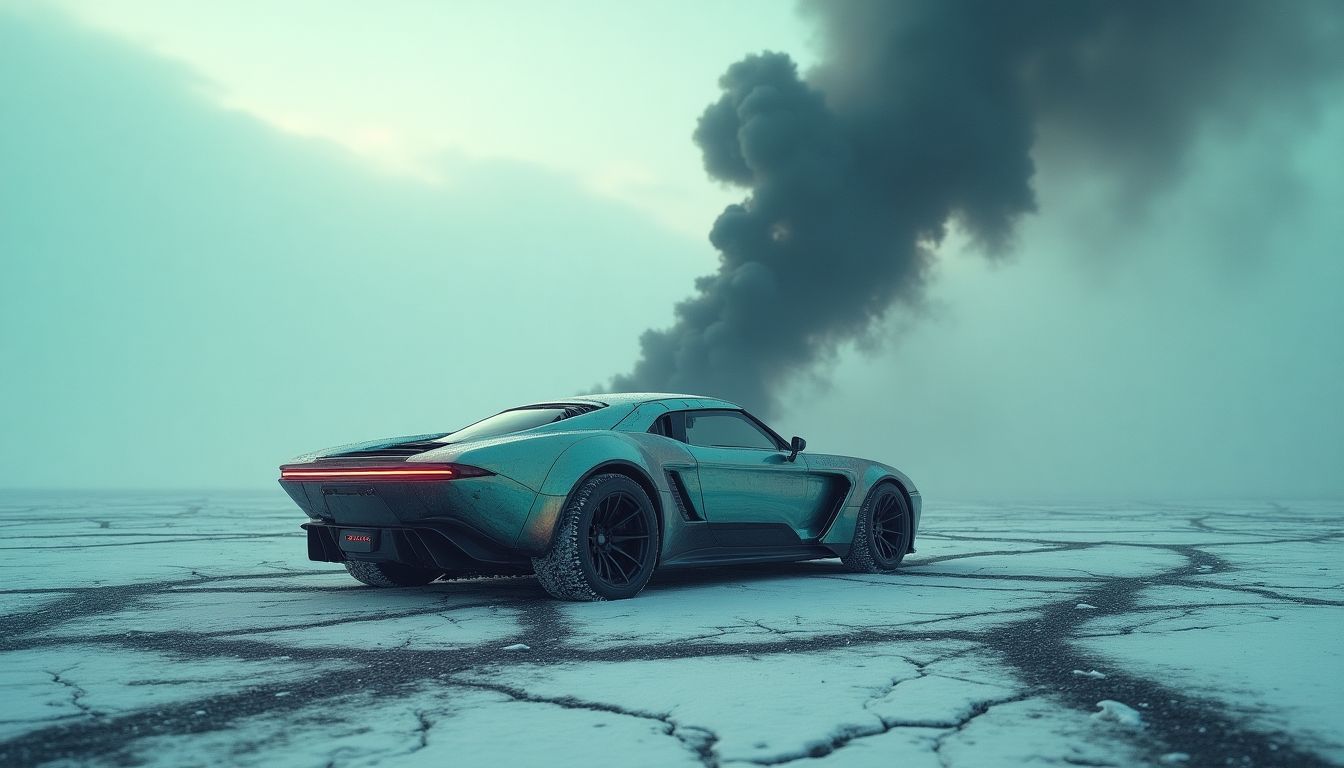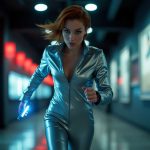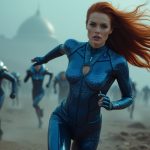The roar of an explosion shattered the early morning calm
Nathan Pierce’s breath rushed out in plumes of vapor against the cold glass of the diner’s window. He leaned forward instinctively, the ceramic coffee mug in his hand trembling. Across the frosted horizon, a plume of smoke twisted unnaturally upward, spiraling as though sucked into the heavens by an invisible tether. Something about it was wrong—not just the magnitude, but its peculiar symmetry, as if choreographed.
Nathan glanced down at the watch on his wrist. The leather strap—scuffed and aged—was the sole remnant of a world long past. Its sleek face displayed more than just time; dark green light weaved data across its surface, offering weather, coordinates, and quantum feedback readings. It had started to glow faintly.
The diner door was wrenched open behind him. “Christ, Nate, tell me you feel that.” Werner, his lanky mechanic partner, stumbled in from the cold, clutching a grease-stained datapad to his chest. His words came out jagged and sharp, like static. "The whole west grid collapsed. Three districts. Gone offline at once."
Nathan nodded without shifting his gaze away from the spiraling smoke. He was already forming the question his lips would soon give sound to.
“How far is the AutoNode from here?”
“Less than six miles,” Werner replied. His face was a pale smear of worry. “Nate, c’mon. Don’t tell me you’re thinking of taking it out again.”
Nathan rose from his seat, pulling a heavy, olive-green overcoat from the back of the chair. In any other decade, he might’ve looked overdressed for a chilly morning, but his attire was functional—an era-appropriate reworking: knee-high boots with crisscrossing leather detail, cream trousers tucked neatly in, and a charcoal turtleneck under the coat. Only the thin band of cerulean light humming at the edge of the coat’s lapels betrayed its truly modern design: nanoweave fabric, thermally adaptive, and coded to him alone.
Werner reached for him. “This has nothing to do with us! The Node failures aren’t our job.”
“But the car is.”
Nathan knew Werner would hesitate, which was all the time he needed. He strode swiftly out of the diner, bracing for the bone-deep cold. Released from its protective thermal cocoon, his watch pulsed—it synced to him automatically—and a holographic image materialized in the air near his palm. Alongside diagrams of a vehicle too futuristic even to sit in anyone’s imagination two decades ago, the image confirmed what Nathan had suspected.
It wasn’t just any car. Nathan Pierce had built it—or rather, he’d finished building it, using blueprints left by his brother before the accident. Only fragments of tech-savvy territories even knew the Corsair existed. And now, every sensor in his self-learning vehicle was linked to the same frequency patterns Nathan’s watch had just identified. The smoking Node wasn’t collapsing naturally; it was calling to him.
Werner finally darted outside, teeth chattering as he caught up. "It's still unstable! The Corsair—it's—you can't test it on this terrain! Not after what happened."
"We don't have time," Nathan snapped.
The Corsair hummed in its docking lot just around the corner, waiting like something born of science fiction against the rust-streaked backdrop of ruined grav-buildings. Its design was sleek but grounded—a marriage of innovation and human craftsmanship. Iridescent steel, shaped into fluid curves, with jagged motifs of deep blue accenting its edges. The car seemed alive. That’s because, in some absurd way, it was. The quantum mechanics that powered its engine weren’t mere talent or ingenuity; they were something else entirely—the key to rewriting energy itself. Nathan had pushed the Corsair to boundaries he sometimes feared it could surpass.
But those boundaries had blurred the night his brother went missing.
The cabin opened with a soft hydraulic hiss and, within seconds, contours of green energy pulsed through the air as the Corsair recognized Nathan. He placed both hands on the steering interface, ignoring Werner’s useless protests. He could feel it, the Corsair syncing to his every thought. That was quantum intuition—what his colleagues dismissed as pseudoscience and what Nathan believed was the key to everything.
He turned his head over his shoulder, quiet now. "Either it works, or none of us make it."
A grim silence passed between him and Werner before the latter jumped into the passenger side. The kid had a knack for loyalty, even if it was usually reluctant.
The moment Nathan accelerated, the Corsair roared like a beast tasting freedom. The road blurred, asphalt bending in ways no car produced by combustion engines or even lithium-ion motors could have. Instead of fuel cells, the Corsair thrived on minimal-wave interactivity: molecules oscillating in superposition, turning friction into formless energy. Inside the cockpit, Nathan's pulse synced to the AI like a dual metronome.
The road toward the AutoNode was blanketed with snow and ash, unnatural disruptions folding in the sky above them. Werner groaned as the Corsair twisted narrowly through sharp bends, its tires—if one could call them that—retracting and flattening as needed against frozen terrain like no traditional tread ever could. Werner checked the readings. Every spike indicated something unprecedented brewing at the Node perimeter.
Then it struck them.
A blur—a beam of shimmering distortion. It clipped the car momentarily, forcing Nathan to hold the wheel steady, white knuckles straining. Whatever anomaly emanated from the AutoNode was growing.
“What was that?” Werner shrieked.
“Not manmade.” Nathan’s breath ghosted over his words. “Werner, if it’s quantum-reactive, the Corsair will interact with it. Hold tight.”
And so it did. As the Corsair reached the final railroad bridge, the world ahead appeared fractured, shimmering like a broken mirror held to sunlight. Shapes and figures—vehicles and structures—collapsed and reassembled midair. But Nathan’s symbiotic vehicle responded to it, slowing itself not by engaging brakes but by calculating nonlinear realities.
“I told you!” Werner spat, eyes glazed with terror. “It isn’t stable. We—we need backup.”
Nathan ignored him. They crossed the threshold—hurtling straight into the realm the Node had broken open. The very landscape folded outward. Nathan’s world blurred into kaleidoscopic hollows of light, and then—silence.
When Nathan opened his eyes, the Corsair stood motionless in a field of impossibilities. The laws of physics no longer applied, and particle streams formed rivers flowing diagonally across the synthetic skyline. Brilliant clouds of turquoise metal hovered above while collapsed highways floated sideways. But directly ahead of them was what he had least anticipated.
A figure emerged from the horizon. Its silhouette was familiar, even after all these years.
His brother, but fractured—like living memories burned into space-time itself.
“Find me where time ends.”
The whispered words reached him as the Corsair charged itself, adapting to power it somehow knew existed in this fracturing quantum anomaly. Nathan didn’t know whether he was chasing destruction or salvation. But as the Corsair sprang into motion once more, one thing burned behind his steely resolve:
The Corsair wasn’t just a vehicle.
The Corsair was a key to rewriting everything.
The Source...check out the great article that inspired this amazing short story: The Quantum Engine: How AI is Revolutionizing Automotive Power with Quantum-Powered Vehicles That Outperform Everything on the Road
Disclaimer: This article may contain affiliate links. If you click on these links and make a purchase, we may receive a commission at no additional cost to you. Our recommendations and reviews are always independent and objective, aiming to provide you with the best information and resources.
Get Exclusive Stories, Photos, Art & Offers - Subscribe Today!

























1 comment